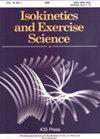Effect of force adjustment modalities on characteristics for force generation and relaxation
IF 0.7
4区 医学
Q4 ENGINEERING, BIOMEDICAL
引用次数: 0
Abstract
BACKGROUND: The systematic characteristics of force generation and relaxation have been investigated using a graded isometric task for several target levels and magnitudes in the upper and lower limb. However, whether a relaxation modality affects the accuracy or speed of grading remains unclear. In addition, speed characteristics are still unclear in both force generation and relaxation modalities. OBJECTIVE: To investigate the effect of force adjustment modalities on force generation and relaxation characteristics. METHODS: Participants were instructed to match a target force level as quickly and as accurately as possible under peak and keep adjustment modalities. The force generation task was increased from 10% to 30%, 50%, and 70% of the maximum voluntary force (MVF). The force relaxation task was decreased from 70% to 50%, 30%, and 10% MVF. The recorded force was analyzed. Errors in reproduction were computed in both modalities and target levels of force. RESULTS: The errors of the peak adjustment modality were greater than those of the keep adjustment modality in both tasks. The reaction time was longer with the peak adjustment modality than with the keep adjustment modality in both tasks. CONCLUSION: Speed was affected by the choice of adjustment modality.力调节方式对力产生和松弛特性的影响
背景:在上肢和下肢的几个目标水平和大小的分级等长任务中,研究了力产生和松弛的系统特征。然而,放松模式是否会影响评分的准确性或速度仍不清楚。此外,速度特性在力产生和松弛模式仍然不清楚。目的:探讨力调节方式对力产生和松弛特性的影响。方法:指导参与者在峰值下尽可能快速准确地匹配目标力水平,并保持调整模式。兵力生成任务从最大自愿兵力(MVF)的10%增加到30%、50%和70%。力松弛任务从70%减少到50%、30%和10% MVF。对记录的力进行分析。在复制过程中计算了两种方式和目标力水平的误差。结果:在两项任务中,峰值调整方式的误差均大于保持调整方式的误差。在两种任务中,峰调整模式下的反应时间都比保持调整模式下的反应时间长。结论:调整方式的选择影响调整速度。
本文章由计算机程序翻译,如有差异,请以英文原文为准。
求助全文
约1分钟内获得全文
求助全文
来源期刊

Isokinetics and Exercise Science
医学-工程:生物医学
CiteScore
1.20
自引率
14.30%
发文量
37
审稿时长
>12 weeks
期刊介绍:
Isokinetics and Exercise Science (IES) is an international journal devoted to the study of theoretical and applied aspects of human muscle performance. Since isokinetic dynamometry constitutes the major tool in this area, the journal takes a particular interest in exploring the considerable potential of this technology.
IES publishes studies associated with the methodology of muscle performance especially with respect to the issues of reproducibility and validity of testing, description of normal and pathological mechanical parameters which are derivable from muscle testing, applications in basic research topics such as motor learning paradigms and electromyography. The journal also publishes studies on applications in clinical settings and technical aspects of the various measurement systems employed in human muscle performance research.
The journal welcomes submissions in the form of research papers, reviews, case studies and technical reports from professionals in the fields of sports medicine, orthopaedic and neurological rehabilitation and exercise physiology.
 求助内容:
求助内容: 应助结果提醒方式:
应助结果提醒方式:


